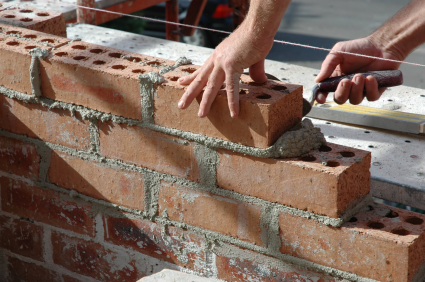You have a website containing dozens if not hundreds of pages containing quality, valuable information. Your site covers all manner of different topics related to your niche.
The search engines love it. Over time you have built up an ‘authority’ site … one content brick at a time … and they have your different pages ranked under a ton of different search terms. They send you visitors every single day who have a real interest in what you have to offer. Potential customers, all of them.
Essentially, it’s traffic on auto-pilot.
It’s not just content on your own site … you’ve also spread your content ‘bricks’ far and wide, and built up similar content on various other sites. (Why the brick analogy? … I’ll explain more soon …)
For example, you have articles, press releases, videos, guest posts, other contributions to blogs, white papers, and so on. All this content similarly attracts readers and directs them straight through to your website.
With all your content building both attracting and sending you traffic on a continuous basis, you couldn’t turn off the traffic tap even if you tried.
And the best bit is, all the traffic you’re getting doesn’t cost you a single cent, other than building the content in the first place. It just keeps on flowing, at no further cost to you.
Contrast that with paid advertising (although there’s nothing to stop you using paid ad tools to help you broaden your content’s reach), where the traffic you get depends on how much you continue to spend.
There’s nothing wrong with paid advertising if you can get it to work effectively for you (which few actually manage to do) – but the fact is, it’s increasingly recognized that the development of quality content is more dependable, has greater longevity, offers a myriad of other benefits, and can offer greater bang for your buck.
As a consequence, companies of all shapes and sizes are now shifting budgets from paid advertising into content marketing (and increasing levels of venture capitalist funding into content marketing-related ventures merely underlines the growing significance and power of content).
It’s not just about traffic of course, it’s about sales and improving your bottom line (see how to monetize your content effectively).
For each page of content you build on your site, a percentage of the targeted traffic you attract will sign up to your list, through which you can start to develop that invaluable long-term relationship with these potential customers (through more content you share with them) … and the sales flow in like clockwork day after day.
Your business has become like child’s play … and it’s all thanks to understanding the importance of content and how each content piece is an investment in the long-term success of your business.
Sound like an impossible pipe dream? For some, it will be, but only because of incorrect mindset … as Henry Ford said:
Whether you think you can, or think you can’t – you’re right.
Henry Ford
Those who think they can‘t, won’t develop or use any content strategy (“Why spend the time when it won’t work anyway?”), will expect instant results from the first few pieces of content, and will become quickly disillusioned. They’ll then give up, stop creating content, and failure is inevitable … but at least they’ll feel good, because they’ve ‘proven’ how right they were in the first place.
On the other hand, those who think they can (or often, know they can, based on their own previous experience) will persist with a clear content strategy, build up their content steadily with one solid content ‘brick’ at a time, and reap the rewards over the long-term. Again, they prove how right they were in the first place.
Pick your belief system, and you so often pre-determine your results too. Choose what you believe wisely.
So Why The Brick Analogy?
My wife and I hope to one day build our own house, and avidly watch and are inspired by home design and house building type programs on the box.
Seems like a lot of hard work, sure, but the results are worth it, and it strikes me that building a successful website, and building a successful (i.e. fit for purpose) house have a lot in common.
For instance, you need to have a fairly clear plan of what you want to achieve – of course, those plans may well be enhanced and adjusted over time, as you gain knowledge from actual experience and clarify your objectives further … but you have a fairly solid idea of where you’re headed.
At the beginning, it seems painstakingly slow, and you don’t see much result from your investment and the work you put in. You obtain the site on which you’re going to build, there’s the planning, the groundwork, connections to various services to establish, and all the foundations to start putting in.
Even after all that work, it seems like not much has happened … you can see very little result, and you wonder what you’re doing it for. But it’s the vision and the knowledge about what you can achieve that keeps you going.
The above applies whether you’re building a house, or a website. Your first few (or more likely, several) pieces of content are very much like the foundations of a new house. You’re doing something, but you don’t seem to be getting much to show for it. Other than a basic shape appearing, it all looks and feels much the same as when you first started.
But the truth is, your foundations are what the rest of the project is built on, and gives your project the strength it needs to stand the test of time. At the beginning, you’ve just got to keep going … adding one solid brick at a time, with faith in the eventual outcome.
Sure, if you want to see instant results, build a house with no foundations … it might work for a while, but sooner or later you can guarantee it’s all going to come crashing down around you. It’s no different with a website …
For those willing and wise enough to stay the course, once you’ve got past the foundational stage, you then start to see some real results.
The house starts taking shape, and you start getting more of a feel for what it will become … the website starts attracting visitors as word spreads, search engines start ranking your content, and your site starts looking and feeling more credible for the long-term.
In both cases, your results start to compound, and the momentum starts to build.
In fact, your results are very much like most growth graphs you may come across – it starts off fairly flat, but then your results begin to curve upwards as you gain traction with your content strategy.
But there’s more to this house-building analogy …
If you’re building with poor materials, you’ll end up with a poorly-built house that will cause problems for you in future, and simply won’t achieve what you’re looking for (presumably a beautiful, comfortable home with minimal maintenance, that just simply ‘works’ in the way you want it to). The better the quality of the materials you build it with, the stronger your outcome will be.
Similarly, with your website, if you’re building with poor quality content, you’re going to get problems – visitors who quickly click away and drive up your bounce rate, search engines that barely send you any traffic because of the lack of value you offer, a lack of credibility, authority and trust with potential customers, and a lack of other businesses who want to partner with you or send powerful opportunities your way.
On the other hand, build with quality content, and the stronger your results will be – each piece, each ‘brick’, of solid, quality content you build onto your site helps build long-term, dependable traffic you can rely on.
Finally, just as with building a house, you wouldn’t expect to do all the actual building yourself (though may well get involved with certain parts of it). Instead, you would hire professionals to take care of it for you, while you maintain the vision, oversee the process and check it’s all being done to plan.
So, for your content strategy, you would hire the professional writers you need to take care of your content creation, while you define what you want them to write about and how it all fits into your content strategy as a whole.
This means you systemize the whole process, and allows you to achieve a great deal more as a result. The same content system can be rolled out for multiple sites for example.
With building a house one brick at a time, you finally create somewhere to live that you can be proud of and that will fit its purpose for many years to come.
Similarly, in building up the quality content on your site one solid content ‘brick’ at a time, you create a website that’s similarly ‘fit for purpose’, that you can be proud of, and that attracts long-term, dependable traffic that will form the bedrock of a successful business for years to come.
Need proof content builds traffic? You’re here aren’t you?





